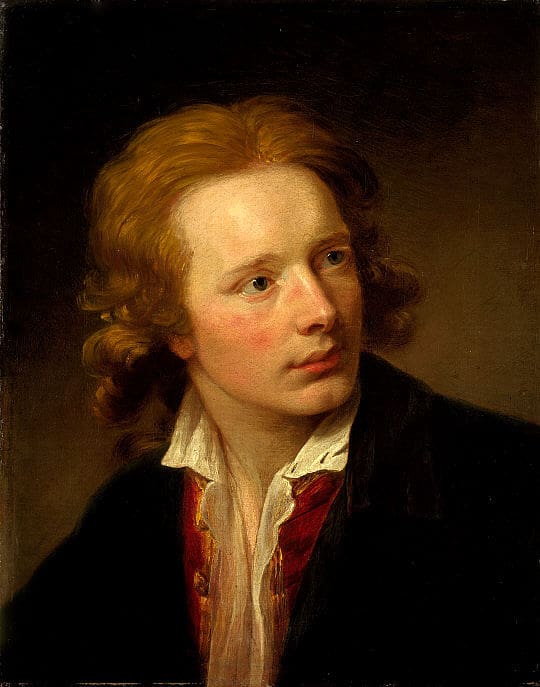This English-made hunting wheellock is an extremely rare gun. Whilea popular firearm made by gunmakers all over the world, very few signed English wheellocks have lasted to present day. This gun, made by Robert Rowland of London sometime between 1704 and 1722 is one of the few survivors.
It’s also fascinating because of its provenance. It can be rare to trace the historical movement of an artifact, especially one of such antiquity. The gun’s lineage of owners doesn’t surface until decades after it was made, however, after that point we have a pretty complete history.
It was purchased by David Martin, court painter to the Prince of Wales in the 1700s (self-portrait above). After he died, it was sold in 1799 by English auctioneer Cornelius Elliot. A lover of all things antique, Thomas Gwennapp bought it and displayed it in his museum, the Oplatheca for many years.
The ownership from 1830 through 1890 goes dark. At the turn of the 20th century, the wheellock made it across the pond and was owned by American industrialist Charles M. Schott. It was then sold to Connecticut financier Valdemar Hammer.
In the 1930s, Charles Cook of Rhode Island acquired the arm. Known arms dealer James Serven ultimately liquidated Cook’s collection and sold this wheellock to Winchester in 1952. It has remained in the collection ever since.

The wheellock came to Cody as part of the Winchester Arms Collection loan in 1975 and became a permanent donation in 1988. The Cody Firearms Museum opened in 1991 and it has been on display ever since.

For more information, visit centerofthewest.org





Pretty cool when you can trace it back like that.
Interesting article and rifle. If you like historical weapons and armor including firearms and are ever in London, don’t miss the Tower of London museum. I spent two days there and wanted more.
Interesting that a nation with such a rich tradition of arms has banned firearms for it’s people. They should have known better.
“…are ever in London, don’t miss the Tower of London museum.”
So much this.
An absolutely fascinating place to see, it just oozes history.
I enjoyed the medieval upstairs part myself, with the torture implements and that *massive* executioner’s block. Looking at all those grooves and the wood stained black from blood, you wonder how many heads were collected on that block.
The downstairs ‘vault’ was also good, with all the armour and whatnot.
I was kinda ‘meh’ on the Crown Jewels, tho…
I’m pretty much in the dark about wheellocks. That trigger gaurd looks like you can put your whole hand in there. Is that typical?
I’m with you, I only showed up here to see the lock system, and we have no pic! Whassup wif dat? What is a wheellock and where does it fit with matchlocks and flintlocks?
“The wheellock works by spinning a spring-loaded steel wheel against a piece of pyrite to generate intense sparks, which ignite gunpowder in a pan, which flashes through a small touchhole to ignite the main charge in the firearm’s barrel. The pyrite is clamped in vise jaws on a spring-loaded arm (or ‘dog’), which rests on the pan cover. When the trigger is pulled, the pan cover automatically opens, and the wheel spins as the pyrite is pressed into contact.
A close modern analogy of the wheellock mechanism is the operation of a modern cigarette lighter…”
Yes, I needed to look up the exact difference.
https://en.wikipedia.org/wiki/Wheellock Cool pictures. It’s impressive how well made some of this stuff was in the 1500’s.
As for the hand guard, I have no idea.
These posts need to make a more frequent appearance on TTAG. They really make me want to plan a vacation around a visit to Cody.
And I gotta point out that Valdemar Hammer is a name badass enough to make a woman grow chest hair after she spoke it.
It sounds like a Harry Potter novel character as well LOL.
You mean it’s not the guy from That 70’s Show?
Just hearing that guys name evokes the “fight or flight” juices.
Thank you Ashley. These posts are awesome.
Good thing I’m not a collector- I’d shoot it, at least once.
This awesome. It sent me on a search for more info on wheellocks, which led me to the discovery that the first assassination of a government figure by firearm occurred in 1570, when the Earl of Moray was shot from a second-story window as his cavalcade passed through the streets of Edinburgh. And then I found out that the first political assassination with a handgun was accomplished in 1584 by a spy who shot the Stadtholder of Holland and Zeeland with a pair of wheellock pistols.
History can be fun. And somebody needs to tell the anti-gun nincompoops that the gun genie escaped from its bottle a lot farther back than they like to think.
Back when I did Renaissance Fairs one of the groups had wheel locks. Elizabethan Faire, so they were period. Always wanted one, but the guy who made the replicas (working, 45 or 50 cal) went out of business.